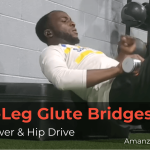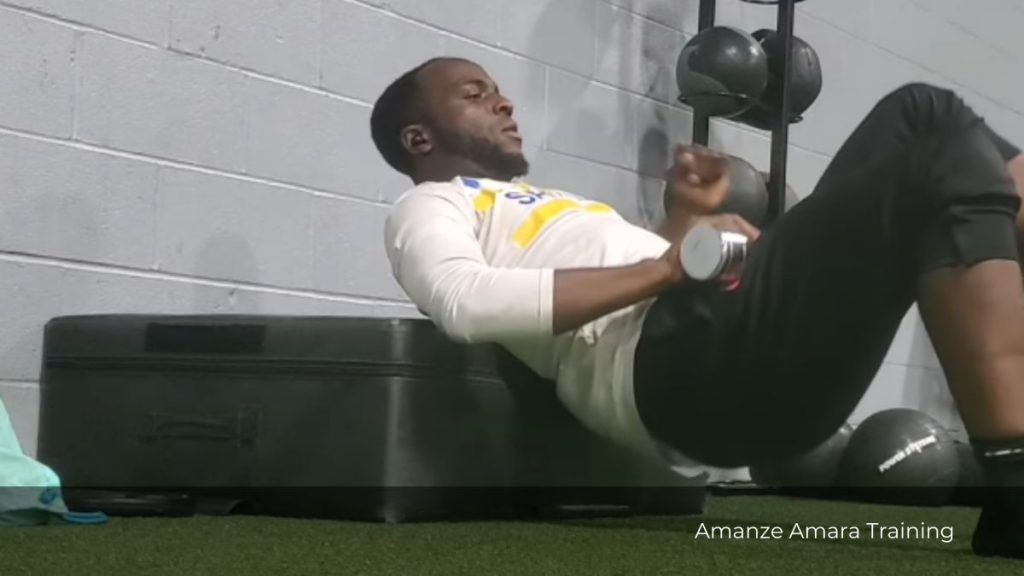
Here’s what this quick guide covers first:

I’ll keep it real — most players don’t think about glute work until tight hips or low-back ache shows up. The truth? Single-Leg Glute Bridges for Soccer are a simple, high-return way to build hip stability, balance, and core control that lasts all 90 minutes.
If you’re asking “what is it, why does it matter, and how do I do it?” — this quick section has you covered. ⚽
Here’s what this quick guide covers first:
At its core, the single-leg glute bridge is a unilateral hip-extension exercise. Lie on your back, plant one heel, extend the other leg, and drive your hips upward while keeping hips level and your core braced. Unlike the two-leg version, the single-leg variation mirrors soccer’s reality — sprints, cuts, and jumps happen off one leg at a time, making it a true soccer hip extension exercise.
Primary targets: gluteus maximus (hip drive).
Secondary: hamstrings and core/pelvic stabilizers for control.
Soccer is a game of tiny margins — hips that stay square, cuts that don’t waste motion, and landings that hold under contact. That’s where single-leg glute bridges for soccer shine: they convert strength into one-legged balance, hip stability, and clean core → hip power transfer. Nail this drill and you’ll feel steadier on first touch, sharper through direction changes, and more resilient from kickoff to stoppage time.
Different positions demand different strengths — the poise to finish under pressure, the endurance to run box-to-box, the power to dominate in duels, or the explosiveness to make a game-saving stop. Single-leg glute bridges for soccer plug into all of these by building hip stability, balance, and posterior chain strength. Let’s break down what this looks like in real match scenarios with players you know.
Technique is everything. To get the most out of single-leg glute bridges for soccer, you want controlled movement, full range, and clean hip drive. Watch the video, then follow along below—this is the exact soccer hip extension exercise setup I use.
I keep it simple: a 12–18″ box (standard gym plyo) with the top of my back resting on the edge. I start on the right side: right foot planted under the knee (shin vertical), right knee bent; the left leg floats off the floor and stays bent. I place a 10–12 lb dumbbell or plate on the right thigh/hip crease and hold it with my right hand. From there, I slowly lower until my right glute nearly touches the ground, then drive through the right heel to full hip extension and hold 3 seconds. I do 3×10 per side. The goal: unilateral glute activation, rock-solid hips, and posterior chain stability for soccer.
3×10 per side, 60–90s rest. Keep the 3-second squeeze at the top and a slow eccentric. Progress load gradually as part of your soccer posterior chain workout. This variation is a great glute bridge vs hip thrust (soccer) option when you want single-leg control, glute bridge sprint power, and smart injury prevention glute training.
That’s the essentials — the what, the why, and the how. If you’re ready to go deeper, the full guide below breaks down muscles worked, the biggest form mistakes, proven variations & progressions, and programming for match-day transfer — plus FAQs and pro tips.
Here’s what the rest of this guide will cover:
Every single-leg glute bridge for soccer lights up a chain of muscles that decide how strong, stable, and explosive you feel on the pitch. When you know what’s firing, you’ll see why this simple soccer hip extension exercise has such a direct impact on balance, hip stability, and sprint power.
Together, these muscles make the single-leg glute bridge more than a gym move — it’s a glute stability drill for football that strengthens your foundation. From hip thrusts into sprints, to core control in duels, this is the kind of training that keeps you powerful, balanced, and injury-resistant through every minute of the match.
If you’re grinding through single-leg glute bridges for soccer, the last thing you want is sloppy form killing your gains. I’ve fallen into these traps before — and trust me, they cost both progress and confidence on the pitch. Here’s what every footballer should avoid when using this soccer hip extension exercise to build posterior chain stability and unilateral glute activation:
Soccer is explosive, but your training needs control. Dropping down and bouncing up turns a glute stability drill for football into wasted movement. Slow the eccentric (lowering phase) and own the squeeze at the top — it’s the difference between casual gym work and real hip drive soccer performance.
This is the classic giveaway. If your hips tilt, one side is stealing the work. But soccer is played one leg at a time — sprints, cuts, and jumps all demand level hips. Keep your pelvis square and even; that’s how you build true posterior chain stability for soccer.
It’s tempting to drive higher by arching your spine — but that shifts the load off the glutes and onto your lower back. Think ribs down, core braced, and push through the heel. Done right, you’ll feel unilateral glute activation that carries straight into sprints and strikes.
Bodyweight bridges are a good start, but stopping there won’t unlock game-changing power. Add a 10–12 lb dumbbell or plate, increase the pause at the top, or extend your rep range. Soccer demands progression — stronger hips today mean faster, more resilient legs tomorrow.
Cutting the range short is like pulling out of a tackle halfway — you’re only fooling yourself. Full hip extension at the top and full control on the way down is what strengthens your glutes for injury prevention glute training soccer. Commit to the complete rep every time.
Avoid these mistakes and the single-leg glute bridge becomes more than a gym drill — it’s a direct investment into your balance, stability, and hip power on the pitch.
Once you’ve mastered the basics of the single-leg glute bridge for soccer, the next step is to progress. Football isn’t static — every sprint, every duel, every jump asks for more. Your training should reflect that. Here are some variations and progressions to keep building unilateral glute activation, posterior chain stability for soccer, and real hip drive soccer performance:
Think of these progressions like match fitness — you don’t stay at preseason intensity all year. You level up. The stronger and more adaptable your glutes become, the more your balance, stability, and hip drive will translate into faster sprints, sharper cuts, and more resilience deep into extra time.
Yes — single-leg glute bridges are one of the best unilateral glute activation drills. They build hip stability, posterior chain strength, and balance that directly translate to soccer movements like sprints, cuts, and jumps. Pair them with single-leg calf raises for a complete lower-leg foundation.
Don’t stop at the gym. Take your glute strength onto the field with plyometrics — bounding, lateral hops, and resisted sprints. This ensures your soccer hip extension exercise translates into faster cuts, quicker reactions, and better balance under pressure.
Football is my first love and I’ll play until my legs fall off. If you want to follow my journey, feel free to check out my pictures and videos. Look forward to more!